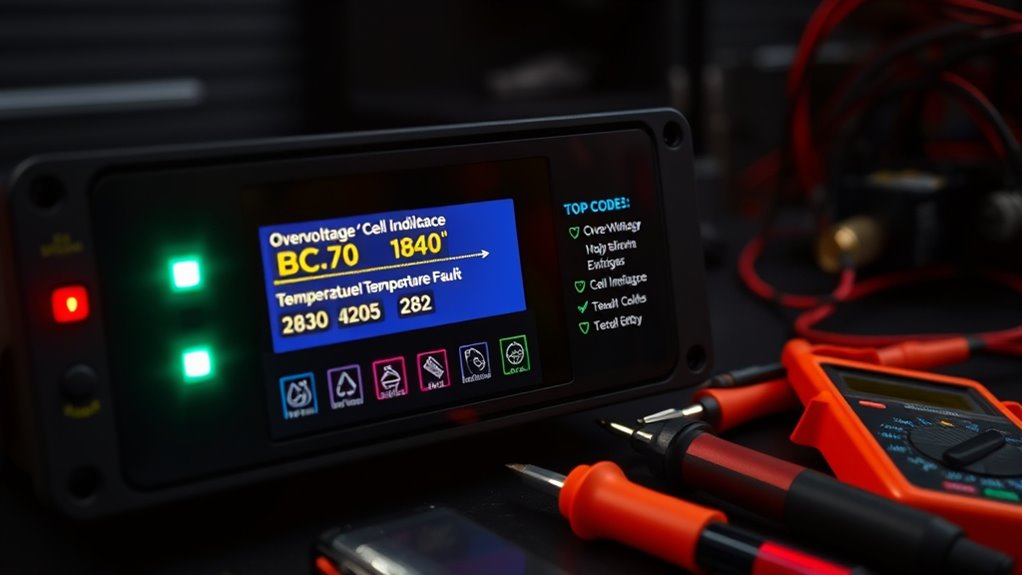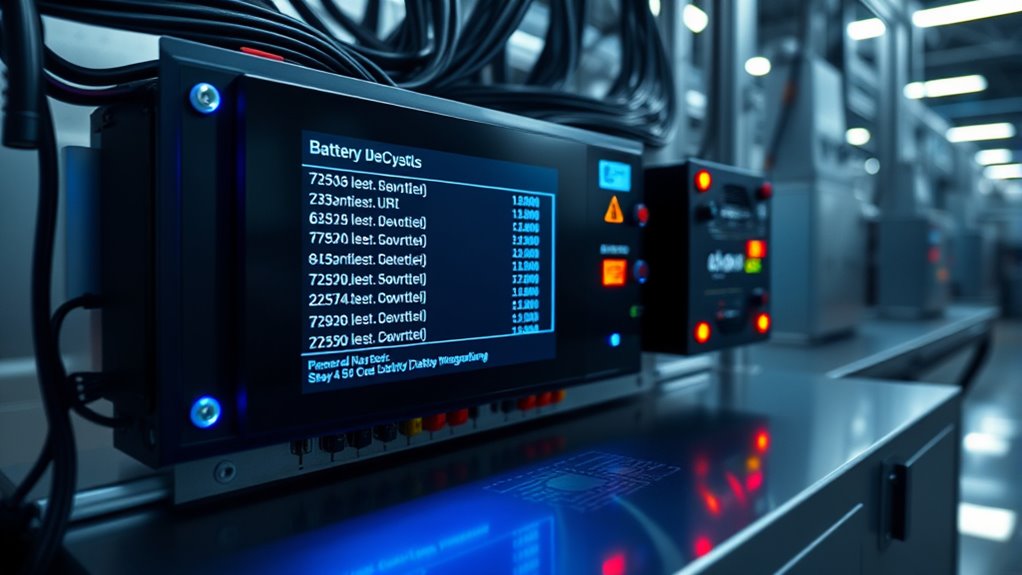To address top BMS error codes, start by checking for voltage, temperature, or communication issues indicated by blinking lights or error codes. Make sure firmware is up-to-date, as outdated software can cause false or missed alarms. Verify cooling systems and connections to resolve thermal or communication errors. Keeping your system properly maintained and updated helps prevent recurring problems. Continue exploring for detailed fixes on specific error codes and how to solve them effectively.
Key Takeaways
- Common error codes include voltage irregularities, temperature alarms, and communication failures, often indicating sensor or connection issues.
- Firmware updates are essential to fix software bugs, improve error detection, and reduce false alarms.
- Temperature-related errors require checking cooling systems and updating firmware for better thermal management.
- Communication errors can be resolved by inspecting connections and updating firmware to ensure protocol compatibility.
- Regularly updating firmware and understanding error codes help prevent system damage and enhance BMS reliability.

Have you ever wondered what those blinking lights or error codes on your battery management system (BMS) mean? They might seem confusing or alarming at first, but understanding them is essential to maintaining battery safety and guaranteeing your system runs smoothly. Error codes often indicate issues like voltage irregularities, temperature anomalies, or communication failures, and recognizing these can help you troubleshoot effectively. One of the most common causes of persistent errors is outdated firmware. Firmware updates are indispensable because they fix bugs, improve performance, and enhance safety features, making your BMS more reliable. Without these updates, your system may misinterpret sensor readings or fail to respond correctly, leading to false error signals or overlooked problems.
When you see an error code related to battery safety, such as overvoltage or undervoltage alerts, it’s a sign that your system detects a potential risk. Addressing these promptly is necessary to prevent damage or safety hazards. Often, these errors stem from sensor calibration issues or outdated firmware that doesn’t recognize the latest battery conditions. Updating your BMS firmware can resolve these issues by guaranteeing the system’s software aligns with your specific battery pack’s parameters. Many BMS manufacturers release firmware updates that improve error detection accuracy, making your system more adept at catching genuine problems versus false alarms. Regularly checking for and installing firmware updates is a simple yet essential step to keep your battery safe.
Some error codes relate to temperature irregularities—either too high or too low. These are critical because extreme temperatures can compromise battery health or cause safety incidents. If you encounter temperature-related error codes, first guarantee your cooling system is functioning correctly. If the hardware is fine, firmware updates may include enhanced algorithms for temperature management, allowing your BMS to better respond to thermal fluctuations. This not only improves safety but also extends your battery’s lifespan.
Communication errors between the BMS and other system components are also common. These can cause false error signals or system shutdowns. To fix this, check physical connections and cables first. If they’re intact, updating the firmware can often restore proper communication protocols, reducing misreads and false alarms. Remember, keeping your firmware current helps your BMS stay compatible with new hardware or software changes, which is essential for ongoing battery safety and performance.
Frequently Asked Questions
How Can I Prevent BMS Error Codes From Appearing?
To prevent BMS error codes, you should focus on proper battery maintenance and error prevention. Regularly check connections, keep the battery clean, and make sure it’s not exposed to extreme temperatures. Avoid overcharging or deep discharging, which can cause errors. Monitoring battery health and addressing minor issues early helps prevent error codes from appearing. Consistent maintenance keeps your system running smoothly and minimizes the chances of encountering these problems.
Are All BMS Error Codes Indicative of Hardware Failure?
Not all BMS error codes mean hardware failure. You should perform a hardware diagnosis to determine if the error code’s significance points to a hardware issue or a software glitch. Sometimes, error codes signal minor problems like loose connections or calibration needs, which you can fix without replacing hardware. Understanding the specific error code helps you identify whether it’s a hardware failure or something that can be addressed through troubleshooting.
Can Software Updates Resolve Persistent Error Codes?
When you encounter persistent error codes, a software update can often help with error resolution. Updates improve the BMS’s firmware, fixing bugs and enhancing communication between components. However, if error codes persist after updating, it might indicate hardware issues. Always verify your system has the latest software, but be prepared to consult a technician if problems continue, as some errors require hardware inspection or repair.
What Safety Precautions Should I Take When Troubleshooting BMS Errors?
Troubleshooting BMS errors feels like defusing a bomb—you need careful precautions. Always prioritize battery safety by wearing insulated gloves and eye protection. Disconnect power before opening the system, and use proper troubleshooting tools to prevent accidental shorts. Never work alone, and keep a fire extinguisher nearby. Following these steps guarantees your safety and helps you diagnose issues accurately without risking damage or injury.
How Long Does It Typically Take to Fix BMS Error Issues?
When addressing BMS error issues, repair timelines vary based on the problem’s complexity. You can expect battery diagnostics to identify the root cause quickly, often within a few hours. Simple fixes may take a day, while more complex repairs could extend to several days. Your proactive approach and accurate diagnostics help speed up the process, ensuring your battery management system gets back to peak performance as swiftly as possible.
Conclusion
By understanding these common error codes, you can gently guide your battery system back to harmony. Addressing these issues early helps prevent minor hiccups from becoming major setbacks, ensuring smoother performance and peace of mind. Remember, every challenge is an opportunity to nurture your system’s health. With patience and care, your battery management system can continue to serve you reliably, quietly supporting your journey forward.










